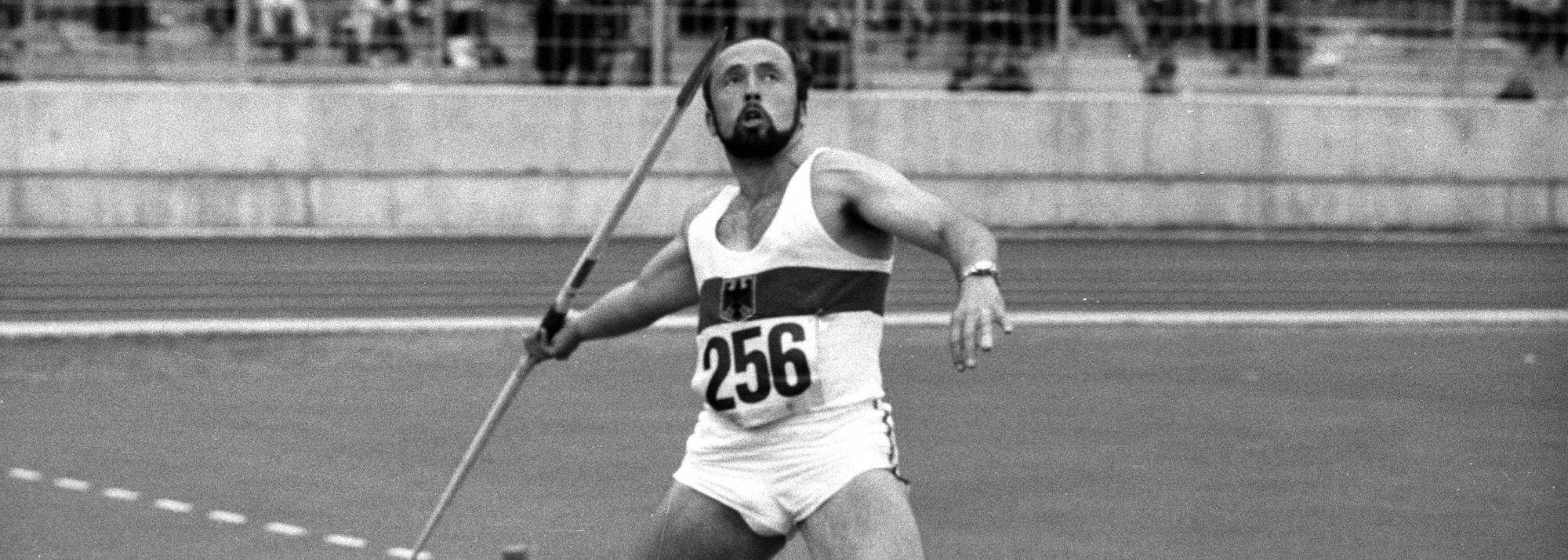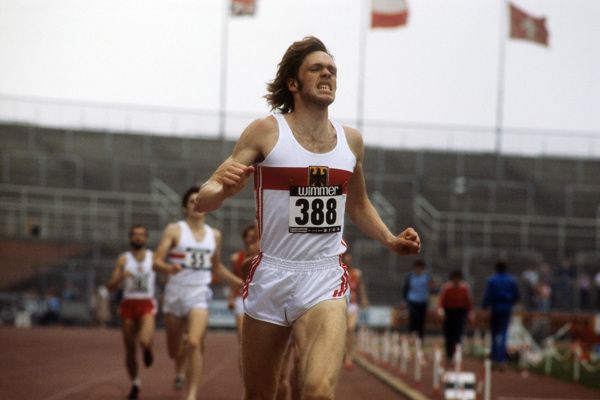1972 Olympic javelin champion Klaus Wolfermann (© IMAGO)
Klaus Wolfermann, the 1972 Olympic javelin champion who one year later became a world record-breaker, recently made the generous donation of his long sleeve jersey from Munich. It is an artefact which has been added to the new Olympic Athletics Collection room inside the virtual Museum of World Athletics (MOWA).
"Please forgive me that I won!"
It was a picture that went around the world: Klaus Wolfermann and Janis Lusis lying in each other's arms at the Munich Olympic Games in 1972, after their memorable duel in the javelin throw. The West German and the Latvian, who competed for the USSR. "I think it was this close embrace which showed everyone that we sportspeople appreciate each other beyond any boundaries set by politics," said Wolfermann. As they hugged, the German competitor uttered this legendary sentence: "Please forgive me that I won!"
Wolfermann had defeated his role model, the clear favourite to win, by two centimetres – 90.48m to 90.46m. "Everyone had their money on Janis, it was a rock solid bet!" he said. Today the German is 75 years old and remembers every detail of this sensational event. He feels like he has told this story a thousand times.
"Far, extremely far"
His javelin was in the air for 4.2 seconds on that Sunday 3 September 1972. It was his fifth attempt that afternoon in the Munich Olympic Stadium. Wolfermann had said to himself just before: "Just go for it, the thing has to really fly!"
He risked everything, taking a slightly longer approach, increasing his speed slightly. The release angle, according to an analysis by Michael Strudler, was nearly 40 degrees.
Even as the javelin was soaring through the air, Wolfermann immediately knew that the throw was "far, extremely far." He had sent the 800g object skyward with just the right touch.
When the javelin landed beyond the 90-metre marker, the 80,000 spectators in the arena went crazy. It was pandemonium. Wolfermann jumped up and down with joy. The scoreboard showed a distance of 90.48m. That was the lead!
Lusis had led in the previous rounds, with 88.88m from the first attempt and 89.54m from the third.
"But we still had the sixth round to go," Wolfermann added. "I knew that Lusis was in top form, he had thrown a world record ahead of Munich with 93.80m. He was a model of concentration, a man with steel nerves. After all, in Mexico 1968 he had won gold with his last attempt. I was curious if he would be able to counter this time!"
Lusis started running, made a small technical error in the last step of his approach, and his javelin landed at 90.46m.
Wolfermann was Olympic champion. "My goal was actually just to get a medal," he said. "But suddenly I had beaten the strongest, most dominant javelin thrower, my absolute role model."
Golden Sunday for FRG
The scenes that followed are unforgettable for anyone who was there that afternoon in the Olympic Stadium. It was the 'golden Sunday' of West German athletics, with three gold medals in one and a half hours. Victories for Hildegard Falck in the 800m, Bernd Kannenberg in the 50km race walk and Wolfermann, as well as silver in the pentathlon for Heide Rosendahl.
"I was just happy that we already had a digital distance measurement then," explained Wolfermann. "Two centimetres are nothing. If they had done it with a tape measure, I wonder if it had been that accurate, say if the grass had been a little uneven." He saved the official result from that day, which gives the difference as 2 centimetres and 6 millimetres.

(© IMAGO)
80,000 spectators in the morning session
Wolfermann had been a competitor at the 1968 Mexico Olympics, where he went out in the qualifying round. Ten days before the Munich Games, he threw over 90 metres for the first time at a test event. He knew he was on form, which he showed impressively at the qualification on 2 September.
It was only 10:30am but the arena was already full with 80,000 spectators. Munich celebrated athletics, the queen of sports, every day.
In the qualification round, Wolfermann easily surpassed the minimum threshold for the final (80m), with 86.22m. That was ideal, as he recognised: "The qualification can destroy you psychologically." There was no anxiety for Wolfermann that day, however. "I got up early, did some stretching, then had breakfast," he said. He did not waste any energy on the qualification and saved his strength for the final between the 12 best competitors, which paid off the next day when it came down to mere centimetres.
The golden throw with such a small margin made him instantly famous. The next day when he visited the Olympic swimming competition, he was placed in the VIP section between the actor from the USA, Kirk Douglas, and Constantine II, King of Greece, who won a gold medal in sailing in Rome 1960.
The "small giant with a golden arm"
The legendary duel also forged a strong bond between Wolfermann and Lusis (who had already been Olympic bronze medallist in 1964). A close friendship developed between them, even across the Iron Curtain.
"Janis visited me quite a few times and was the surprise guest at my 60th birthday party!" he remembered.
Wolfermann and Lusis regularly went back to the site of their momentous competition together. Sitting in the revolving restaurant in Munich’s Olympic Tower, they looked down on the Olympic Stadium's plexiglass roof and reminisced.
Since Lusis died in April 2020, Wolfermann has kept in touch with his son Voldemars, himself a participant in the Olympic javelin throw in 2000 and 2004. A friendship that has bridged generations.
Wolfermann, who with his 1.76m height was dubbed the "small giant with a golden arm" by German media, celebrated his gold thoroughly in autumn 1972 at various events and parties.
"Then I got a bad conscience in January 1973 and went back to training hard, almost obsessively!" he said. His coach made it clear to him that his success might continue: "Just you wait – now that you are Olympic champion, you are more relaxed. That means you can really fulfil your potential." And fulfil it he did.
Ahead of the first competition in spring 1973, he knew he was in top form. "Two days ahead of the meeting I threw the women's javelin (600gm) 120 metres in the final training session. That looked good," Wolfermann remembered with a laugh.
In Leverkusen, on 5 May 1973, he threw a world record in his second attempt with 94.08m. Now he had also taken the world record from Lusis, who had thrown his 93.80m in Stockholm the previous year.
Born of Finnish birch
Javelin was becoming very popular in Germany at the time. Wolfermann says that the spectators were enthusiastic about a sport with a long and historic tradition. After all, it was originally simply a form of hunting. Without wanting to diminish any other discipline, he thinks that the fascination came from the elegance, the easily observable long flight of the javelin, and being able to see the distance of the throw immediately.
He had sensed this fascination when he first competed in Scandinavia at the start of his career. "Meetings in Sweden and Finland were always in my diary," he said. "We always asked ourselves what these Northerners did differently to us!"
Later, he and his coach discovered at least part of the answer. One small piece of the puzzle that led to Nordic dominance was that children, especially in Finland, would often see javelin competition on television and practiced throwing early in life, even if it was just throwing stones into the sea or the country’s numerous lakes, as Wolfermann explained.
His own beginnings had been slightly different. As a boy he did gymnastics ("My father was a gymnast, after all!") and then handball. At 14, he realised how good he was at throwing, how much power there was in his arm. When he tried pitching balls, he threw a ball 100m. Then he tried a wooden javelin, a Finnish birch model. It flew 45 metres – this was the moment the Olympic javelin champion in him was born.
Olaf Brockmann for World Athletics Heritage









